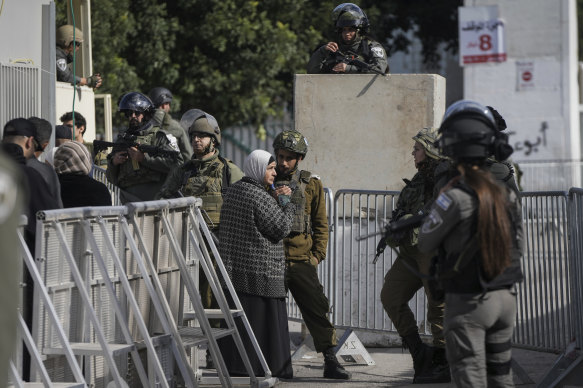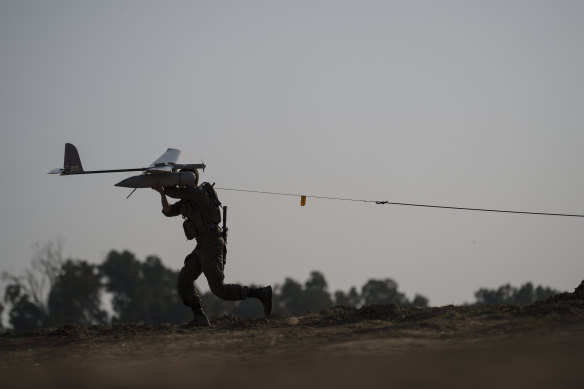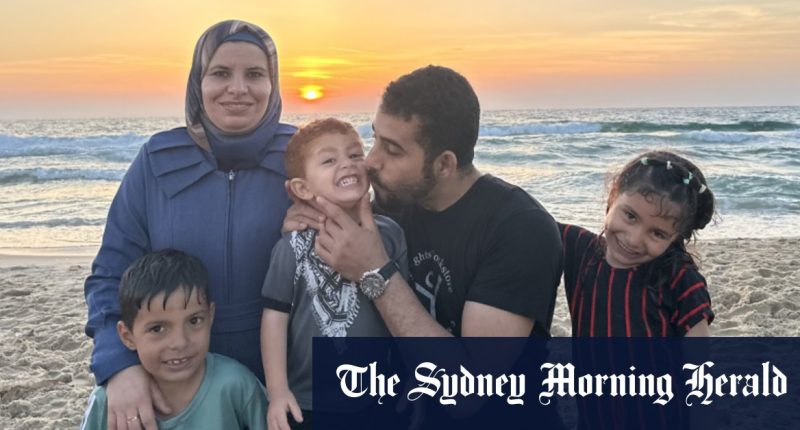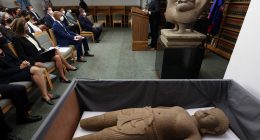An Israeli army spokesperson declined to comment on activity in Gaza but said the military “carries out necessary security and intelligence operations, while making significant efforts to minimise harm to the uninvolved population”. He added, “Naturally, we cannot refer to operational and intelligence capabilities in this context”.
Facial recognition technology has spread across the globe in recent years, fuelled by increasingly sophisticated AI systems. While some countries use the technology to make air travel easier, China and Russia have deployed the technology against minority groups and to suppress dissent. Israel’s use of facial recognition in Gaza stands out as an application of the technology in a war.

Palestinians go through a security check by Israeli soldiers as they cross from the West Bank city of Bethlehem to Jerusalem to participate in Friday prayers at the Al-Aqsa Mosque.Credit: AP
Matt Mahmoudi, a researcher with Amnesty International, said Israel’s use of facial recognition was a concern because it could lead to “a complete dehumanisation of Palestinians” where they were not seen as individuals. He added that Israeli soldiers were unlikely to question the technology when it identified a person as being part of a militant group, even though the technology makes mistakes.
Israel previously used facial recognition in the West Bank and east Jerusalem, according to an Amnesty report last year, but the effort in Gaza goes further.
In the West Bank and east Jerusalem, Israelis have a homegrown facial recognition system called Blue Wolf, according to the Amnesty report. At checkpoints in West Bank cities such as Hebron, Palestinians are scanned by high-resolution cameras before being permitted to pass. Soldiers also use smartphone apps to scan the faces of Palestinians and add them to a database, the report said.
In Gaza, which Israel withdrew from in 2005, no facial recognition technology was present. Surveillance of Hamas in Gaza was instead conducted by tapping phone lines, interrogating Palestinian prisoners, harvesting drone footage, getting access to private social media accounts and hacking into telecommunications systems, Israeli intelligence officers said.

An Israeli soldier prepares to launch a drone near the Israeli-Gaza border, southern Israel in January.Credit: AP
After October 7, Israeli intelligence officers in Unit 8200 turned to that surveillance for information on the Hamas militants who breached Israel’s borders. The unit also combed through footage of the attacks from security cameras, as well as videos uploaded by Hamas on social media, one officer said. He said the unit had been told to create a “hit list” of Hamas members who participated in the attack.
Corsight was then brought in to create a facial recognition program in Gaza, three Israeli intelligence officers said.
The company, with headquarters in Tel Aviv, says on its website that its technology requires less than 50 per cent of a face to be visible for accurate recognition. Robert Watts, Corsight’s president, posted this month on LinkedIn that the facial recognition technology could work with “extreme angles, (even from drones), darkness, poor quality”.
Loading
Corsight declined to comment for this story.
Unit 8200 personnel soon found that Corsight’s technology struggled if footage was grainy and faces were obscured, one officer said. When the military tried identifying the bodies of Israelis killed October 7, the technology could not always work for people whose faces had been injured. There were also false positives or cases when a person was mistakenly identified as being connected to Hamas, the officer said.
To supplement Corsight’s technology, Israeli officers used Google Photos, the free photo sharing and storage service from Google, three intelligence officers said. By uploading a database of known persons to Google Photos, Israeli officers could use the service’s photo search function to identify people.
Google’s ability to match faces and identify people even with only a small portion of their face visible was superior to other technology, one officer said. The military continued to use Corsight because it was customisable, the officers said.
Loading
A Google spokesperson said Google Photos was a free consumer product that “does not provide identities for unknown people in photographs”.
The facial recognition program in Gaza grew as Israel expanded its military offensive there. Israeli soldiers entering Gaza were given cameras equipped with the technology. Soldiers also set up checkpoints along major roads that Palestinians were using to flee areas of heavy fighting, with cameras that scanned faces.
The program’s goals were to search for Israeli hostages, as well as Hamas fighters who could be detained for questioning, the Israeli intelligence officers said.
The guidelines of whom to stop were intentionally broad, one said. Palestinian prisoners were asked to name people from their communities who they believed were part of Hamas. Israel would then search for those people, hoping they would yield more intelligence.
Abu Toha, the Palestinian poet, was named as a Hamas operative by someone in the northern Gaza town of Beit Lahia, where he lived with his family, the Israeli intelligence officers said. The officers said there was no specific intelligence attached to his file explaining a connection to Hamas.
In an interview, Abu Toha, who wrote Things You May Find Hidden in My Ear: Poems From Gaza, said he has no connection to Hamas.
When he and his family were stopped at the military checkpoint November 19 as they tried leaving for Egypt, he said he had not shown any identification when he was asked to step out of the crowd.
After he was handcuffed and taken to sit under a tent with several dozen men, he heard someone say the Israeli army had used a “new technology” on the group. Within 30 minutes, Israeli soldiers called him by his full legal name.
Abu Toha said he was beaten and interrogated in an Israeli detention centre for two days before being returned to Gaza with no explanation. He wrote about his experience in The New Yorker, where he is a contributor. He credited his release to a campaign led by journalists at The New Yorker and other publications.
Upon his release, Israeli soldiers told him his interrogation had been a mistake, he said.
In a statement at the time, the Israeli military said Abu Toha was taken for questioning because of “intelligence indicating a number of interactions between several civilians and terror organisations inside the Gaza Strip”.
Abu Toha, who is now in Cairo with his family, said he was not aware of any facial recognition program in Gaza.
“I did not know Israel was capturing or recording my face,” he said. But Israel has “been watching us for years from the sky with their drones. They have been watching us gardening and going to schools and kissing our wives. I feel like I have been watched for so long.”
Also Read More: World News | Entertainment News | Celebrity News








